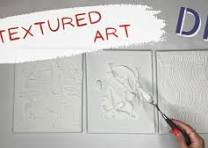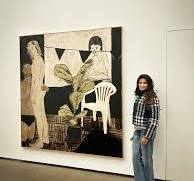The Beauty of Textured Art
Textured art is a captivating form of artistic expression that engages both the visual and tactile senses. Through the use of various materials and techniques, artists create depth, dimension, and richness in their artworks, inviting viewers to explore not just with their eyes but also with their hands.
One of the defining characteristics of textured art is its ability to add a dynamic element to a piece. By incorporating different textures such as rough, smooth, bumpy, or glossy surfaces, artists can create contrast and visual interest that captivate the viewer’s attention. The interplay of light and shadow on textured surfaces adds another layer of complexity, enhancing the overall aesthetic appeal.
Texture in art can be achieved through a variety of mediums, including paint application techniques like impasto or dry brushing, collage elements such as fabric or paper, sculptural additions like mixed media or found objects, and even digital manipulation for contemporary artworks. Each method offers unique possibilities for artists to experiment and push the boundaries of traditional artistic practices.
Textured art not only stimulates the senses but also conveys emotions and narratives in a more visceral way. The tactile nature of textured surfaces allows artists to communicate texture’s symbolic meanings – roughness for struggle or resilience, smoothness for calm or serenity – creating a deeper connection between the artwork and its audience.
Whether it’s in abstract paintings that invite touch or mixed media sculptures that demand exploration, textured art offers a multisensory experience that transcends traditional visual art forms. It challenges viewers to engage with art in new ways, fostering a deeper appreciation for the power of texture in creative expression.
Next time you encounter a textured artwork, take a moment to appreciate the intricate details and tactile qualities that make it truly unique. Let yourself be drawn into the world of textured art and discover the beauty that lies beneath its surface.
Mastering Textured Art: 8 Tips for Adding Depth and Interest to Your Creations
- Experiment with different textures to add depth and interest to your art.
- Use a variety of materials such as sand, fabric, or paper to create unique textures.
- Consider the relationship between light and texture to enhance the visual impact of your artwork.
- Don’t be afraid to mix different textures in one piece for a dynamic composition.
- Use tools like palette knives or sponges to create specific textures in your artwork.
- Think about the tactile quality of your art and how viewers may interact with it physically.
- Practice layering techniques to build up texture gradually and achieve the desired effect.
- Study other artists’ textured work for inspiration and learn new techniques.
Experiment with different textures to add depth and interest to your art.
Experimenting with various textures is a valuable tip to enhance the depth and visual interest of your art. By incorporating a diverse range of textures into your artwork, you can create layers of complexity that engage the viewer’s senses and elevate the overall aesthetic appeal. Whether through mixing different painting techniques, adding tactile elements like fabric or sand, or exploring unconventional materials, experimenting with textures allows you to push the boundaries of traditional art forms and unlock new creative possibilities. Embrace the opportunity to play with textures in your art to enrich your work with depth, dimension, and a unique sensory experience for your audience.
Use a variety of materials such as sand, fabric, or paper to create unique textures.
To enhance the richness and depth of textured art, artists can experiment with a diverse range of materials like sand, fabric, or paper. Incorporating these tactile elements into their artworks adds a unique dimension that engages both the visual and tactile senses of the viewer. By combining different textures, artists can create dynamic compositions that invite exploration and evoke emotional responses. The use of varied materials opens up endless creative possibilities, allowing artists to craft truly distinctive pieces that resonate with audiences on a deeper level.
Consider the relationship between light and texture to enhance the visual impact of your artwork.
When creating textured art, it is essential to consider the relationship between light and texture to elevate the visual impact of your artwork. The way light interacts with different textures can dramatically affect the overall look and feel of a piece. By strategically manipulating light and shadow on textured surfaces, artists can enhance depth, highlight intricate details, and create a dynamic interplay that adds a sense of dimensionality to the artwork. This thoughtful consideration of light and texture not only enriches the visual experience but also brings a new level of sophistication and complexity to the artistic composition.
Don’t be afraid to mix different textures in one piece for a dynamic composition.
When creating textured art, don’t hesitate to combine various textures within a single piece to achieve a dynamic composition. Mixing different textures can add depth, interest, and complexity to your artwork, creating a visually stimulating experience for the viewer. By experimenting with contrasting textures such as rough and smooth or matte and glossy, you can enhance the overall aesthetic appeal of your piece and create a harmonious balance that draws attention and invites exploration. Embrace the versatility of texture in art to push the boundaries of creativity and bring your artistic vision to life in a captivating way.
Use tools like palette knives or sponges to create specific textures in your artwork.
To enhance the texture in your artwork, consider using tools such as palette knives or sponges to achieve specific textures. Palette knives allow for precise application of paint, creating raised surfaces and intricate patterns that add depth and dimension to your piece. On the other hand, sponges can be used to dab, stipple, or blend colors, resulting in soft and organic textures that evoke a sense of movement and fluidity. Experimenting with different tools gives you the opportunity to explore a wide range of textures and unleash your creativity in new and exciting ways.
Think about the tactile quality of your art and how viewers may interact with it physically.
When creating textured art, it is essential to consider the tactile quality of the artwork and how viewers may physically interact with it. By incorporating different textures and surfaces, artists can evoke a sensory experience that goes beyond visual appreciation. Thinking about how viewers may touch, feel, and engage with the artwork adds an interactive dimension that enhances the overall impact of the piece. Whether through subtle variations in texture or bold contrasts in materials, inviting viewers to explore the artwork through touch can create a deeper connection and appreciation for the artistic creation.
Practice layering techniques to build up texture gradually and achieve the desired effect.
To enhance the richness and depth of textured art, it is essential to practice layering techniques diligently. By building up texture gradually through layers, artists can achieve the desired effect with precision and control. Each layer adds complexity and dimension to the artwork, allowing for a nuanced interplay of textures that captivate the viewer’s attention. Through patience and experimentation with different materials and application methods, artists can master the art of layering to create visually stunning and tactilely engaging pieces that speak volumes about their creative vision and skill.
Study other artists’ textured work for inspiration and learn new techniques.
Studying other artists’ textured work can be a valuable source of inspiration and a great way to expand your artistic repertoire by learning new techniques. By closely examining how other artists use texture in their creations, you can gain insights into different approaches, materials, and methods that you may not have considered before. This exploration of textured art from various perspectives can spark creativity, challenge your own artistic boundaries, and ultimately enrich your own artistic practice.





